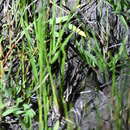en
names in breadcrumbs


Like other night adders, C. bilineatus inflates its body when angry and hisses and puffs, it will strike if further molested (Spawls et al., 2002).
Two-striped night adder
These snakes reach a maximum size of about 65 cm, the average size is between 30 to 50 cm. The dorsal pattern consists of brown scales contrasted by irregular or vaguely rectangular black patches that run all along the back. There are usually two distinct, narrow pale dorsolateral stripes that run the length of the body. There are random black scales and oblique black bars on the flanks. On the head there is a characteristic V-shaped mark, which may be black, or black-edged with a brown infilling. The ventral scales are dark cream colored. (Spawls, et al., 2002)
There are 17 (occasionally 15 or 18) scale rows at midbody, 119 to 144 ventral scales, and 18 to 35 subcaudal scales (Spawls et al., 2002).
The diet of C. bilineatus consists mostly of anurans. Like other members of its genus, it is known to consume toads, indicating that they are resistant to bufadienolides (Spawls et al., 2002).
Angola, northern Zambia, Zaire (Shaba Province) and Rwanda. Spawls and Branch, 1995, Dangerous Snakes of Africa, provided a distribution map for the species.
Coastal Kenya and Tanzania through eastern Africa (Malawi, Zambia, Zimbabwe, Mozambique) to South Africa (Northern, Mpumalanga and KwaZulu-Natal Provinces) as far south as Durban, and on Zanzibar Island.
C. bilineatus is similar to C. rhombeatus, which has a broader head and does not have the two narrow dorsolateral lines that give this species its name. Patternless individuals are known and may be difficult to identify (Spawls et al., 2002).
Syntype: BMNH 1905.5.29.36-40
Causus bilineatus is a viper species endemic to south central Africa.[2] No subspecies are currently recognized.[3][4] Common names include lined night adder,[2] two-lined night adder,[3] and two-striped night adder.[3][5] Like all other vipers, it is venomous.
The average total length (body + tail) is 30–50 cm (12–20 in) with a reported maximum of 65 cm (26 in).[2]
The head is slightly distinct from the neck, while the snout is fairly long and tapering. Midbody there are 15–18 rows of dorsal scales that are weakly keeled and have a soft and velvety appearance. The ventral scales number 122–141 in males and 128–144 in females. There are 18–30 subcaudals.[2]
The color pattern consists of an ash to auburn to brown ground color, overlaid with numerous irregular or vaguely rectangular black dorsal patches. These patches lie within two distinct and narrow pale stripes that run the length of the body. The belly color is dark to dark cream.[2]
Causus bilineatus is found in Angola, Zambia, southern DR Congo, Rwanda, and western Tanzania.[3]
The type locality is given by Boulenger (1905) as "between Benguella and Bihé" (Angola). Bocage (1895) listed "Duque de Bragança, Quissange, Caconda, and Huilla" (Angola) for the localities.[1]
Occurs in moist savanna, forest-savanna environments, and swampy habitats. Wild-caught specimens found to have eaten clawed frogs, Xenopus, suggest a more aquatic nature than other species.[2]
Preys mostly upon toads and frogs, particularly the clawed frog, Xenopus.[2]
Causus bilineatus is a viper species endemic to south central Africa. No subspecies are currently recognized. Common names include lined night adder, two-lined night adder, and two-striped night adder. Like all other vipers, it is venomous.